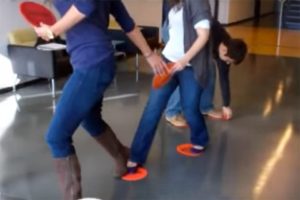Student Contributor: L. Witmer
 Cross the River can be used to help students build community and respect for one another. Because students are asked to collaborate and work together to formulate a solution to the problem presented to them with limited resources, this activity will help students establish relationships with each other and move towards being able to work as a team.
Cross the River can be used to help students build community and respect for one another. Because students are asked to collaborate and work together to formulate a solution to the problem presented to them with limited resources, this activity will help students establish relationships with each other and move towards being able to work as a team.
Cross the River is a team building activity in which students are introduced to a scenario where they are explorers who must get all of their group across an imaginary river filled with vicious crocodiles (or any other potentially harmful creature/substance you can think of) in order to escape a forest fire. If anyone touches the contents of the river, they will be eaten – if anyone is left behind, they will be burnt. The only resources they have available to them are a set number (which can vary depending on the number and age of participants) of ‘magic stones’, which will fly away if not being actively used as flotation devices. There is no one correct way to succeed in completing this task – student creativity and cooperation is strongly encouraged. This exercise works best in an area with plenty of space. You can use pretty much anything available to you for the ‘magic stones’, ranging from small mats to paper plates. I have frequently utilized this activity when working with children at summer camps. It can be an excellent way to encourage students to learn how to communicate and problem solve effectively with each other in a respectful way.
 I chose to categorize Cross the River as a Preventative Management Phase tool because of the emphasis we place on community building in this phase. As a teambuilding exercise, it makes sense that this activity would eventually lead to helping establish a positive classroom community. The only way for them to succeed is to listen to each other and be supportive as they work together to get across the designated space safely. In a way, it also connects to the Supportive Phase, because we continue to work on community building even after we shift from Preventative to Supportive. Students can be reminded of the lessons they learned during this exercise when problems do arise during the Corrective Phase. I think Cross the River fits best with student directed and collaborative theories of influence. Students are actively learning how to work together as a group to make decisions, but the teacher can step in at any time to mediate discussion and provide scaffolding, and there is more than one way to complete the challenge. Allowing students to have a voice when it comes to making decisions within the class is an element that appears in both these theories of influence.
I chose to categorize Cross the River as a Preventative Management Phase tool because of the emphasis we place on community building in this phase. As a teambuilding exercise, it makes sense that this activity would eventually lead to helping establish a positive classroom community. The only way for them to succeed is to listen to each other and be supportive as they work together to get across the designated space safely. In a way, it also connects to the Supportive Phase, because we continue to work on community building even after we shift from Preventative to Supportive. Students can be reminded of the lessons they learned during this exercise when problems do arise during the Corrective Phase. I think Cross the River fits best with student directed and collaborative theories of influence. Students are actively learning how to work together as a group to make decisions, but the teacher can step in at any time to mediate discussion and provide scaffolding, and there is more than one way to complete the challenge. Allowing students to have a voice when it comes to making decisions within the class is an element that appears in both these theories of influence.
More Information –
Tool Source: I got this idea from various mentors from the summer camp I work at (Camp Dart-Lo).
https://bit.ly/2FAfEjM


